Recently, we were in a discussion in which a participant argued that there is no basis for concern about the Alaska economy (nor, by implication, about Alaska families). Their view was that, while it had its ups and downs, using Gross Domestic Product (GDP) as a measure, the size of the overall Alaska economy has “nearly tripled” since 2000, and, with Conoco’s Willow and Santos’ Pikka oil fields on the horizon, is well positioned to continue to grow similarly into the future.
They also used the measure to praise the period during which Governor Mike Dunleavy (R – Alaska) has been governor. Their view was that Alaska GDP had already grown by “nearly a third again” from 2018 to 2024 alone.
That, of course, sent us in search of the numbers and their significance.
As calculated by the US Department of Commerce’s Bureau of Economic Affairs (BEA), on a nominal basis, Alaska GDP (or, as some refer to it, Gross State Product) was $26.9 billion in calendar year 2000. For 2024, the most recent period for which numbers are available, it was $72.6 billion, $45.6 billion, or 2.7 times higher than in 2024. That’s not quite three times, but close enough if rounded.
For those who are interested in such things, that equates to a compound annual growth rate of 4.2% over the period.
As for the period over which Governor Dunleavy has presided, in 2018, again on a nominal basis, Alaska GDP was $54.8 billion. 2024’s $72.6 billion is, indeed, 33% – or a third – higher. That equates to a compound annual growth rate over the period of an even higher 4.8%.
But both sets of those numbers are on a “nominal” basis; in other words, they include – and are heavily influenced by – inflation (or, as Dunleavy might put it, “thanks, Biden”). The story looks significantly different when stated on a “real,” or inflation-adjusted, basis.
Again using BEA numbers, the “real” growth in GDP between 2000 and 2024 adjusted for inflation (using “chained 2017 dollars”) is only $17.5 billion, or roughly 50% (0.5 times) instead of 2.7 times. That reflects a compound annual real growth rate of only 1.6%, instead of 4.2%. The “real” growth between 2018 and 2024 is only $3.47 billion, or 7%, reflecting a compound annual real growth rate over that period of only a little over 1%, which is lower than for the period as a whole.
To put those numbers in perspective, the compound annual real growth rate in overall US GDP over the same period has been over 2.2%. Alaska’s is significantly below that.
Here’s what the comparison between Alaska’s nominal and real GDP growth looks like when done as an index:
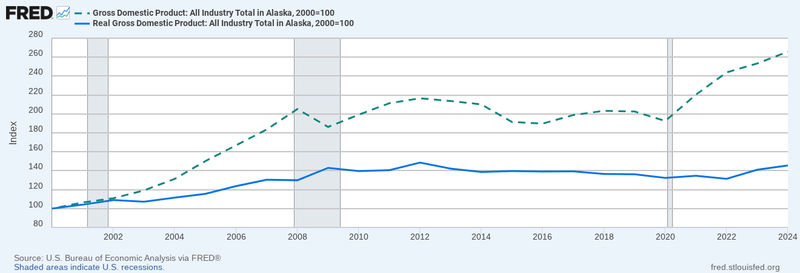
Looking at the chart, it becomes clear that, rather than being “turbo-charged” over the period as some have claimed, on a real basis (the solid line), the Alaska economy has remained relatively staid, largely flatlining from 2009 (for reference, the end of former Governor Sarah Palin’s term in office) forward.
But even that limited amount of “real” growth looks significant when compared to what has happened to real Alaska household income over the same period.
On a real basis, Alaska’s median household income is only 1% higher in 2024 than in 2000. On an inflation-adjusted basis (using 2024 dollars), Alaska median household income was $90,360 in 2000; it was $91,620 in 2024. Because of a significant dip in 2018, Alaska median household income was only $84,540 in that year. Its recovery to 2024’s $91,620 represents an 8% increase over that period, or a compound annual real growth rate of 1.35%. But the increase only returns Alaskans essentially to the same level of real median household income they had in 2000.
To add perspective, here is a comparison of the change in real GDP over the period versus the change in real median household income, done as an index:
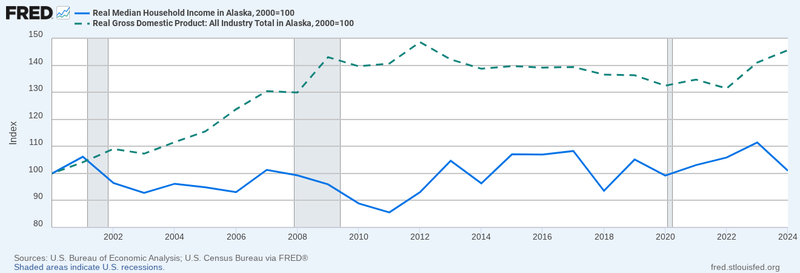
Even the limited growth in real Alaska GDP over the period looks positively buoyant when compared to what has happened to real median Alaska household income. While real Alaska GDP has increased by roughly 50% over the period, real median Alaska household income has ended up no better off than it was at the start.
In short, while Alaska, as measured by real GDP, is somewhat better off over the period, Alaskans, as measured by real median Alaska household income, aren’t. As these numbers show, the overall economy, as measured by real GDP, is disconnected from the reality faced by Alaskan households.
For perspective, we have also compared the experience of the median Alaska household over the period against those in Texas, Oregon, Washington, and Florida, the primary states to which Alaskan families have recently been migrating.
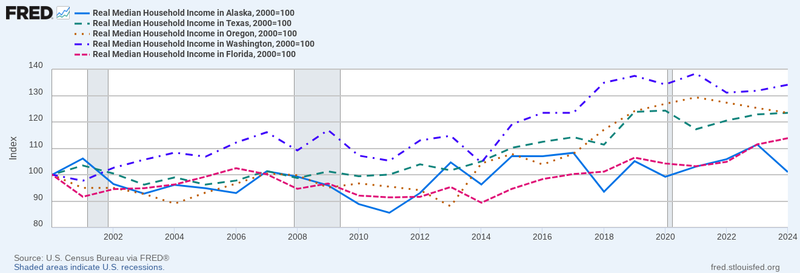
Not surprisingly, given the outmigration to them, households in the other states have done much better over the period than those in Alaska. While real median Alaska household income has largely stagnated over the period, rising only 1% in nearly a quarter of a century, Florida’s has increased by 14%, both Texas’s and Oregon’s by 23.5%, and Washington’s by 34%.
Here are the absolute amounts for those states over the period.
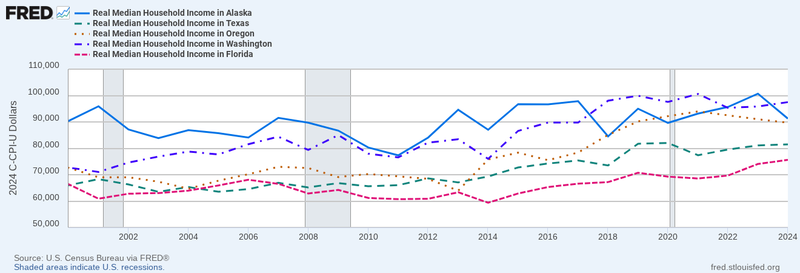
While Alaskans started 2000 with a significant advantage in median household income over the other states, that advantage has mostly dissipated over the period. By the end, the real median Alaska household income ranks behind Washington’s, is roughly even with Oregon’s, and is still ahead, but significantly less so than at the beginning of the period, of Texas’s and Florida’s.
The same evolution occurs when comparing Alaska to other, somewhat similarly situated, lower-populated Western states against which it is sometimes measured. Here is the index comparing changes in real median Alaska household income with those in Montana, Wyoming, and the Dakotas over the period.
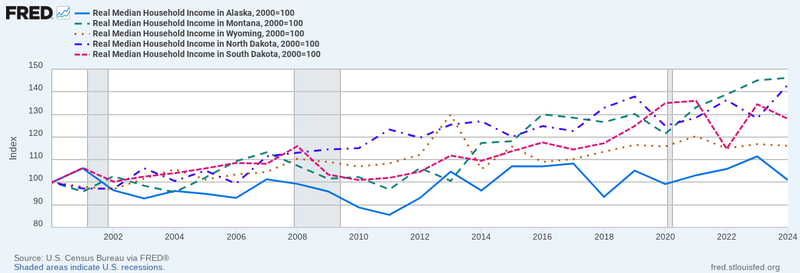
While Alaska’s real median household income remains stagnant, all of the other states improve. While Alaska’s real median household income improves by only 1% over the period, Wyoming’s rises by 16%, South Dakota’s by 28%, North Dakota’s by 43% and Montana’s by 46%. To add some additional perspective, overall US real median household income has also improved by over 16% over the same period.
Here are the absolute amounts over the period for the same states:
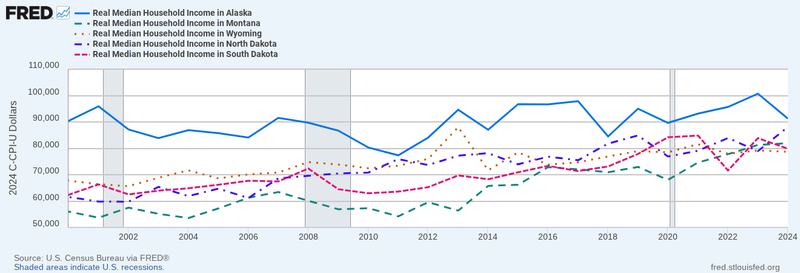
Again, while Alaskans start the period with a significant advantage in median household income compared to the other states, that advantage dissipates. While Alaska’s real median household income remains slightly higher at the end of the period than that of the other states, all of them have significantly narrowed the difference.
As some might anticipate, given the previous focus of some of these columns, we see a significant Permanent Fund Dividend (PFD) issue embedded in these numbers. As an example, Alaska’s end-of-period (2024) median household income would have been roughly $4,800 higher had that year’s PFD not been cut. The result would have been that, instead of only 1% growth over the 24 years, the median Alaska household would have experienced real growth of roughly 7%. That’s still not as much as those of the other states included in the above comparisons, but it is materially better than its actual performance.
There is also a mystery embedded in the numbers. If real Alaska GDP has grown over the period, but not real median Alaska household income, where has the benefit of the incremental economic activity gone? Many will speculate on that – and we may also dig into the issue in future columns – but our point for purposes of this column is simply this: it’s not gone to the average Alaska family.
At this point, we will leave a more detailed look at those related issues to subsequent columns. For the present, we want to keep the focus of this column entirely on the significant disparity over the last two and a half decades between the relatively material change in Alaska GDP, which many use as a key indicator of Alaska’s economic health, compared to the (complete lack of) change in median Alaska household income, which is a key indicator of the economic health of Alaska families.
By focusing on Alaska GDP – particularly, nominal GDP – as the measure of the health of the state’s economy, many are missing entirely what is happening to the economic health of Alaska’s households. There is a significant difference between how “Alaska” is doing economically and how “Alaskans” are doing. Even if the overall Alaska economy, measured by real GDP, is doing moderately ok, the economic situation of Alaskan households isn’t.
Going forward, both the Governor and the Legislature should focus much more directly on the latter. After all, isn’t that ultimately why they are in those jobs?
Brad Keithley is the Managing Director of Alaskans for Sustainable Budgets, a project focused on developing and advocating for economically robust and durable state fiscal policies. You can follow the work of the project on its website, at @AK4SB on Twitter, on its Facebook page or by subscribing to its weekly podcast on Substack.






“……….As some might anticipate, given the previous focus of some of these columns, we see a significant Permanent Fund Dividend (PFD) issue embedded in these numbers……….”
Of course, we knew it was coming.
I don’t understand Reggie Taylor’s comment.
“Of course, we knew it was coming.”
-Reggie Taylor
Is Reggie saying that he belongs to a group (“we”) that has been expecting a PFD issue embedded in certain numbers above dealing with “Alaska’s real median household income?”
A group has been expecting that? What group?
What t f does that mean?
I swear on six pocket bibles I have no idea what Reggie’s comment means. And I do try, truly.
Anyone?
“……..I don’t understand…….”
Of course you don’t. You never did.
Hint:
Re-read the words I quoted, sit in a quiet room, and see if it absorbs…………
No time for that Reg, I’m already onto the next article spewing off the top with nothing reasonable or intelligent to say!
Yes, you are. See ya’ there………..all of you…………..
The key is labor scarcity; the local economy has to grow faster than the population. They paid well during the oil boom and 2000s because they needed to tempt talent to come up from the lower 48. Now, we have stagnated. The oil tap has been cut off, and we didn’t wisely invest in manufacturing to anchor jobs here. Instead, we relied on the benevolence of our government to properly fund the Permanent Fund. We could have easily produced goods and exported them to the lower 48 or even Asia, but it was too expensive they said. Cheaper to ship… Read more »